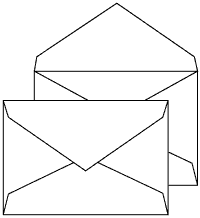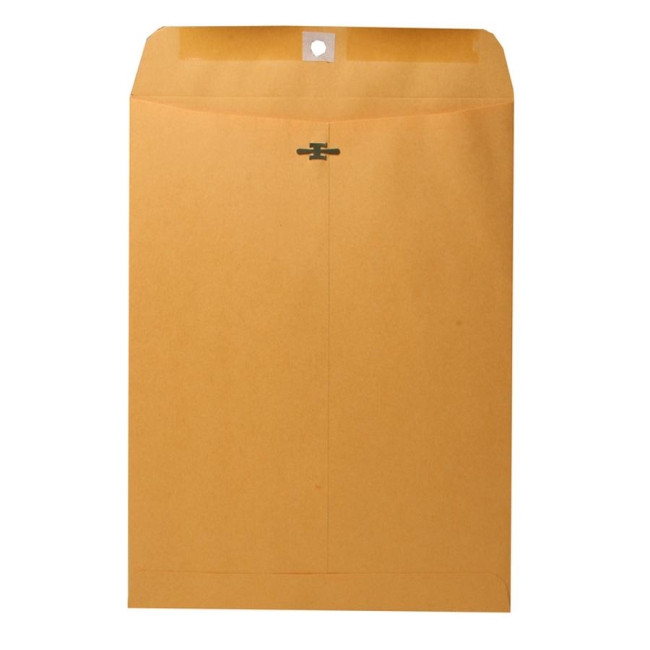Printable Version:
General Terms:
Baronial- A style of announcement envelope commonly used for greeting cards and stationery. Baronial envelopes consist of a pointed flap and diagonal seams.
Bleed- An image that is printed and extended off of the envelope.
Close Registration- Refers to the proximity of copy to a fixed point when printing two or more colors close together.
Corner Card- The upper corner of an envelope containing a return address or other identification information.
Dot Gain- Printing larger ‘dots’ than usual to create darker colors and tones.
Halftone- A screening method for printing of a continuous tone image. This method uses dots of all sizes to create highlights, low lights, and mid-tones.
Heavy Coverage- A design that consists of heavy color and images.
Inside Tint- Also known as a security tint, and inside tint is printed on the inside of the envelope to make the envelope opaque or less transparent.
Jet Printing- an Offset process the prints on folded envelopes on a machine capable of printing 2-5 colors.
Litho- The process of printing that uses a blanket to transfer an image from the plate to the envelope.
Machine Insertable- An envelope that is specifically made to be put through machines that insert its contents.
Make Ready- Additional envelopes needed to set up a job on the machines.
Offset Lithography- A printing method that requires the plated image to be offset onto a blanket cylinder and then prints to the envelope.
Pantone (PMS)- The Pantone Matching System is a book of colors used to match colors with the ink formulas used for printing.
PDF- Standing for Printable Document Format, PDF file format is used for sending and viewing files on the computer.
Process Color (CMYK)- Method of printing with two or more half tone plates to create a variety of colors.
Regular Envelope- An envelope used for commercial and banking use.
Remittance Envelope- A style of envelope used for donations and collections. This envelope has a large flap that can be printed on both sides.
Special Window- Any envelope with a non-standard window.
Spot Color- Color requiring separate plates for each color to be printed.
Throat- The space between the bottom flap and and the top of an envelope.
Tint- An area of an image on the envelope that is shaded, or an image printed inside the envelope to make the envelope opaque.
Tolerance- A margin of 1/8″ on an envelope.
Window Position- Location of a window on an envelope, which is measured from the left and bottom edges.
Web Envelope- An envelope that is made from rolled paper that is not die cut.
White Wove- A type of paper that is made only for envelopes.
Envelope Seams:
Center Seams- Paper seams on coin and catalog envelopes that are located in the middle of the envelope.
Diagonal Seams- Paper seams on pointed flap and commercial envelopes that create diagonals on the left and right of the envelope.
Side Seams- Paper seams are located on the sides of the back of the envelope, creating a large space for printing. Side seams are commonly used for booklet and collection envelopes.
Envelope Seals and Closures:
Remoistening Seal- An seal made up of a gum on the flap that is activated by moistening the area.
Split Seal- Similar to a remoistening seal, split seals consist of smaller sections of gum to activate. This seal is better for envelopes being stored in humid conditions.
Latex Seal- Latex adhesive is applied to the envelope and the flap that seals together when the areas are joined together.
Redi-Seal- Similar to the latex seal, a redi-seal consists of latex adhesive on two areas of the envelope. However, a redi-seal is specially folded to keep them apart.
Clasp- A closure secured by a double-pronged metal clasp.
Peel and Seal- Resin adhesive that is covered by a tape liner. Once the tape is removed, the flap will seal without moisture.
Envelope Measurements:
Booklets vs. Catalogs- Booklets open up the longer side side of the envelope, while Catalogs open on the shorter side of the envelope. Booklet openings are also known as open side envelopes. Catalog openings are also known as open end envelopes.
Commercials and Officials-
| 6-1/4 | 3-1/2 x 6 |
| 6-3/4 | 3-5/8 x 6-1/2 |
| 7 | 3-3/4 x 6-3/4 |
| 7-3/4 | 3-7/8 x 7-1/2 |
| Monarch | 3-7/8 x 7-1/2 |
| Check | 3-5/8 x 8-5/8 |
| 9 | 3-7/8 x 8-7/8 |
| 10 | 4-1/8 x 9-1/2 |
| 11 | 4-1/2 x 10-3/8 |
| 12 | 4-3/4 x 11 |
| 14 | 5 x 11-1/2 |
Standard Window Sizes and Positions-
| SIZE | FROM LEFT | BOTTOM | |
| 6-1/4 | 1-1/8 x 4-1/2 | 7/8″ | 1/2″ |
| 6-3/4 | 1-1/8 x 4-1/2 | 7/8″ | 1/2″ |
| 7 | 1-1/8 x 4-1/2 | 7/8″ | 1/2″ |
| 7-3/4 | 1-1/8 x 4-1/2 | 7/8″ | 1/2″ |
| Monarch | 1-1/8 x 4-1/2 | 7/8″ | 1/2″ |
| 8-5/8 | 1-1/8 x 4-1/2 | 3/4″ | 13/16″ |
| 9 | 1-1/8 x 4-1/2 | 7/8″ | 1/2″ |
| 10 | 1-1/8 x 4-1/2 | 7/8″ | 1/2″ |
| 10 Right Hand | 1-1/8 x 4-1/2 | 4-1/8″ | 1/2″ |
| 10 Full View | 3 x 8 | Centered | Centered |
| 11 | 1-1/8 x 4-1/2 | 7/8″ | 1/2″ |
| 12 | 1-1/8 x 4-1/2 | 7/8″ | 1/2″ |
| 14 | 1-1/8 x 4-1/2 | 7/8″ | 1/2″ |
Open Ends-
| 10 | Policy | 4-1/8 x 9-1/2 |
| 11 | Policy | 4-1/2 x 10-3/8 |
| 12 | Policy | 4-3/4 x 11 |
| 14 | Policy | 5 x 11-1/2 |
| 1 | Catalog | 6 x 9 |
| 1-1/4 | Catalog | 6-1/2 x 9-1/2 |
| 3 | Catalog | 7 x 10 |
| 6 | Catalog | 7-1/2 x 10-1/2 |
| 9-3/4 | Catalog | 8-3/4 x 11-1/4 |
| 10-1/2 | Catalog | 9 x 12 |
| 12-1/2 | Catalog | 9-1/2 x 12-1/2 |
| 13-1/2 | Catalog | 10 x 13 |
| 14-1/2 | Catalog | 11-1/2 x 14-1/2 |
| 15 | Catalog | 10 x 15 |
| 15-1/2 | Catalog | 12 x 15-1/2 |
Booklets-
| 6-1/2 | 6 x 9 |
| 6-5/8 | 6 x 9-1/2 |
| 6-3/4 | 6-1/2 x 9-1/2 |
| 7-1/2 | 7-1/2 x 10-1/2 |
| 9 | 8-3/4 x 11-1/2 |
| 9-1/2 | 9 x 12 |
| 10 | 9-1/2 x 12-1/2 |
| 13 | 10 x 13 |
Coins-
| 5 | 2-7/8 x 5-1/4 |
| 5-1/2 | 3-1/8 x 5-1/2 |
| 6 | 3-3/8 x 6 |
| 7 | 3-1/2 x 6-1/2 |
Announcement Envelopes-
| A2 | 4-3/8 x 5-3/4 |
| A6 | 4-3/4 x 6-1/2 |
| A7 | 5-1/4 x 7-1/4 |
| A8 | 5-1/2 x 8-1/8 |
| A9 | 5-3/4 x 8-3/4 |
| A10 | 6 x 9-1/2 |
| Slimline | 3-7/8 x 8-7/8 |
Baronial Envelopes-
| 4 Bar | 3-5/8 x 5-1/8 |
| 5 Bar | 4-1/8 x 5-5/8 |
| 5-1/2 Bar | 4-3/8 x 5-3/4 |
| 6 Bar | 4-3/4 x 6-1/2 |
| Lee | 5-1/4 x 7-1/4 |




